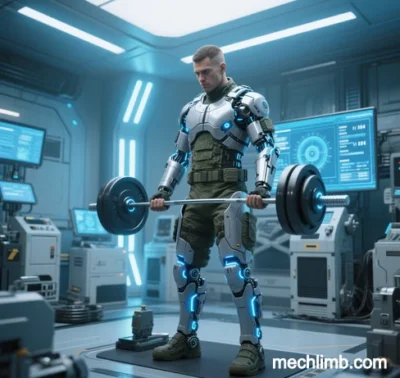
MechLimb: Applications and Innovations in Mechanical Bionic Limbs
MechLimb, a fusion of biomedical engineering, mechatronics, and AI, aims to restore or enhance human mobility and sensory capabilities through mechanized and biomimetic design. This article explores six key application scenarios, supported by technical implementations and case studies.
I. Medical Rehabilitation and Functional Restoration
- Prosthetic Mobility for Amputees:
- EMG-Controlled Prosthetics: Surface or implanted sensors convert muscle signals into mechanical actions. For example, DARPA’s Luke Arm enables users to perform complex tasks like grasping and rotation with near-natural precision.
- Active Knee Systems: Sensors adjust damping and torque in real time to support running and stair-climbing, overcoming limitations of passive prosthetics.
- Stroke and Spinal Injury Recovery:
- Exoskeleton-Assisted Training: Devices like EksoNR integrate EMG/EEG signals to provide gait-correcting torque, improving walking distance and symmetry.
- Closed-Loop Neural Feedback: HAL-ML exoskeletons decode motion intent via brain-computer interfaces (BCI), enhancing walking speed in spinal injury patients.
II. Industrial and Occupational Support
- Heavy Labor Assistance:
- Industrial Exoskeletons: Low-profile multi-link structures provide passive spring assistance for overhead and cross-body tasks, reducing muscle fatigue and repetitive strain injuries.
- Adaptive Impedance Control: Adjusts stiffness dynamically to optimize human-machine synergy in lifting and assembly tasks.
- Precision Operations:
- Advanced Prosthetic Hands: Carbon-fiber 3D-printed limbs (e.g., i-LIMB Hand) enable independent finger movement and tactile feedback for tasks like screwdriving and typing.
III. Specialized Environments
- Underwater and Space Exploration:
- Soft Robotic Arms: Jointless, lightweight designs perform gripping and probing in confined spaces, ideal for deep-sea or spacecraft maintenance.
- Pressure-Resistant Prosthetics: Titanium osseointegration implants reduce infection risks for divers and astronauts in high-pressure settings.
- Disaster Response:
- Explosion-Resistant Exoskeletons: Equipped with carbon-fiber armor and thermal imaging, these systems aid rescue operations in extreme conditions like fires and earthquakes.
IV. Military and Extreme Performance
- Tactical Enhancements:
- High-Capacity Exoskeletons: Military-grade systems like HULC carry heavy loads while boosting soldier mobility and endurance.
- Stealth Prosthetics: Noise-dampened biomimetic limbs support covert operations with near-silent movement.
- Battlefield Adaptability:
- Rapid Prosthetic Fitting: Modular systems (e.g., Avalon K2) enable limb scanning and assembly in minutes for quick redeployment.
- Post-Trauma Neural Repair: Flexible electrode arrays restore neural pathways, recovering grip strength in paralyzed subjects.
V. Daily Life and Athletic Performance
- Sports Enhancement:
- Elite Prosthetic Legs: Gradient carbon-fiber arches adapt to terrain slopes, while energy-recovery systems extend battery life for athletes.
- Running Blades: Biomechanical designs like Cheetah Flex-Foot achieve high energy storage efficiency for competitive use.
- Sensory Restoration:
- Multimodal Tactile Feedback: Devices like SEM Glove™ restore pressure, vibration, and temperature perception for natural environmental interaction.
VI. Cutting-Edge Research and Future Scenarios
- Bio-Mechanical Fusion:
- Optogenetic Control: Engineered astrocytes release lactate under light stimulation, reversing post-trauma synaptic loss.
- 3D-Bioprinted Sensory Organs: Transplantable structures restore temperature and pressure perception in burn patients.
- Quantum Sensing:
- Nanoscale Probes: Diamond-based sensors detect neuron-level strain for ultra-early Parkinson’s diagnosis.
Challenges and Future Directions
- Energy Density: Improving prosthetic actuator power density beyond current limits.
- Biocompatibility: Extending signal stability in implants with advanced materials like PEDOT:PSS-Chitosan hydrogels.
- Equity: Open-source platforms and low-cost actuators democratize access in developing nations.
Conclusion
MechLimb technologies are redefining human-machine collaboration across healthcare, industry, military, and daily life. Advances in biohybrid interfaces, quantum sensing, and cloud-driven neural adaptation promise a future of seamless, boundary-free sensory and motor enhancement.
Data sourced from public references. For collaboration or domain inquiries, contact: chuanchuan810@gmail.com





